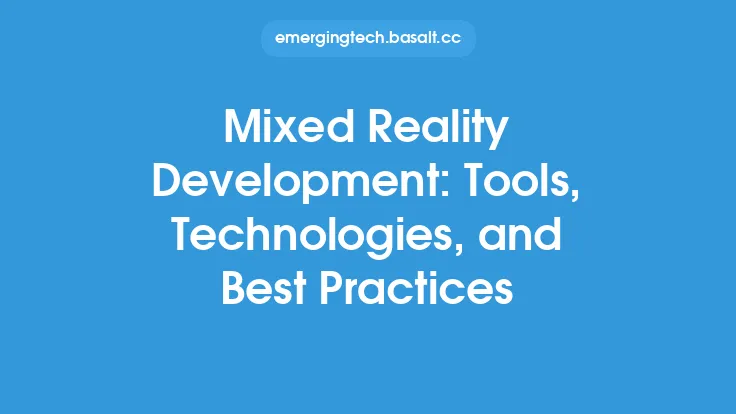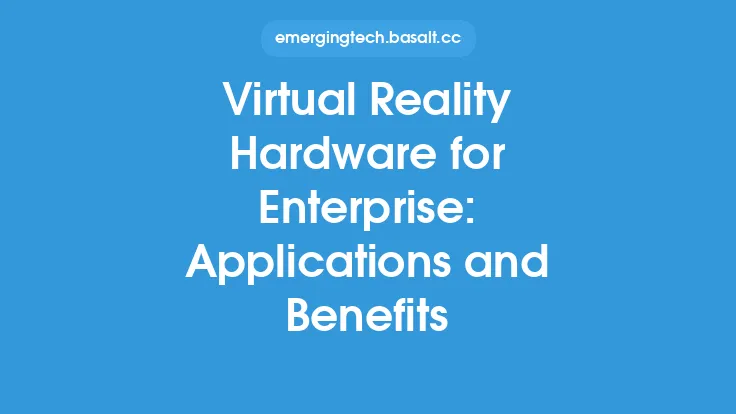The world of virtual and augmented reality has expanded to include a new and exciting technology: mixed reality. While these three terms are often used interchangeably, they have distinct differences in terms of their functionality, application, and user experience. In this article, we will delve into the key differences between mixed reality, virtual reality, and augmented reality, exploring their unique characteristics, technical requirements, and potential uses.
Introduction to Virtual Reality
Virtual reality (VR) is a computer-generated simulation of a three-dimensional environment that can be experienced and interacted with in a seemingly real or physical way. VR technology uses a combination of hardware and software to create an immersive and interactive experience, shutting out the physical world and replacing it with a virtual one. VR headsets, such as Oculus Rift or HTC Vive, are used to display the virtual environment, and users can interact with it using controllers or other devices. The primary goal of VR is to transport the user to a new and artificial world, providing an escape from reality.
Introduction to Augmented Reality
Augmented reality (AR) is a technology that overlays digital information and images onto the real world, using the camera and display of a device such as a smartphone or tablet. AR enhances the real world by adding virtual objects, sounds, or other sensory inputs that can be seen, heard, or even felt. Unlike VR, AR does not create a completely artificial environment; instead, it blends digital and physical elements to create a new and interactive experience. AR applications, such as Pokémon Go or Snapchat filters, use the device's camera to display virtual objects or information in the real world, allowing users to interact with them in a seamless and intuitive way.
Introduction to Mixed Reality
Mixed reality (MR) is a hybrid technology that combines elements of both virtual and augmented reality. MR creates an environment where virtual objects and real-world objects coexist and interact with each other in real-time. Unlike AR, which simply overlays digital information onto the real world, MR creates a more immersive and interactive experience by allowing virtual objects to be anchored to real-world objects and environments. MR technology uses advanced sensors, cameras, and display systems to track the user's movements and surroundings, creating a seamless and interactive experience. MR devices, such as Microsoft HoloLens or Magic Leap One, use see-through displays to project virtual objects into the real world, allowing users to see and interact with both virtual and real objects simultaneously.
Key Differences Between Mixed Reality, Virtual Reality, and Augmented Reality
The key differences between MR, VR, and AR lie in their functionality, application, and user experience. VR is designed to transport the user to a new and artificial world, shutting out the physical environment. AR, on the other hand, enhances the real world by adding virtual objects and information, but does not create a completely artificial environment. MR, as a hybrid technology, combines elements of both VR and AR, creating an environment where virtual and real-world objects coexist and interact with each other. In terms of technical requirements, VR requires a high-performance computer and a dedicated headset, while AR can run on a variety of devices, including smartphones and tablets. MR, due to its hybrid nature, requires more advanced hardware and software, including see-through displays, advanced sensors, and high-performance processors.
Technical Requirements and Limitations
The technical requirements and limitations of MR, VR, and AR vary significantly. VR requires a high-performance computer, a dedicated headset, and advanced controllers to provide an immersive and interactive experience. AR, on the other hand, can run on a variety of devices, including smartphones and tablets, but may require additional hardware such as cameras and sensors to provide a seamless experience. MR, due to its hybrid nature, requires more advanced hardware and software, including see-through displays, advanced sensors, and high-performance processors. The limitations of MR, VR, and AR include issues such as latency, resolution, and field of view, which can affect the user experience and overall performance of the technology.
Potential Uses and Applications
The potential uses and applications of MR, VR, and AR vary significantly. VR is commonly used in gaming, entertainment, and education, providing an immersive and interactive experience for users. AR is used in a variety of applications, including gaming, marketing, and education, enhancing the real world with virtual objects and information. MR, due to its hybrid nature, has a wide range of potential applications, including gaming, education, healthcare, and architecture. MR can be used to create interactive and immersive experiences that combine virtual and real-world objects, providing a new and innovative way to interact with and understand complex information.
Conclusion
In conclusion, mixed reality, virtual reality, and augmented reality are distinct technologies with unique characteristics, technical requirements, and potential uses. While VR is designed to transport the user to a new and artificial world, AR enhances the real world by adding virtual objects and information. MR, as a hybrid technology, combines elements of both VR and AR, creating an environment where virtual and real-world objects coexist and interact with each other. Understanding the key differences between these technologies is essential for developers, businesses, and users to unlock their full potential and create innovative and interactive experiences that transform the way we live, work, and play.





